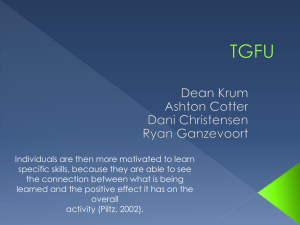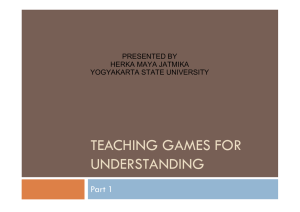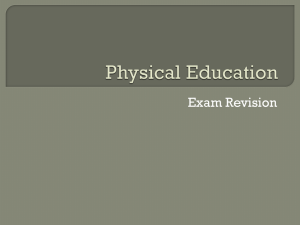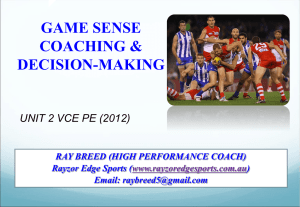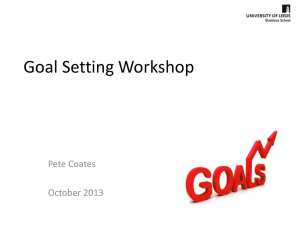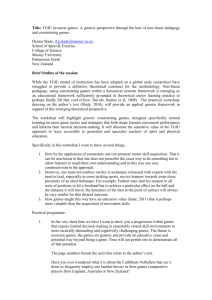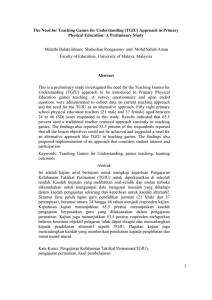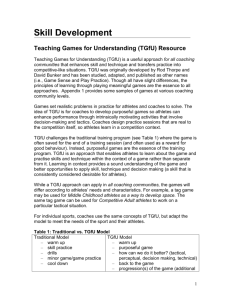Workshop 3: Games approach
advertisement
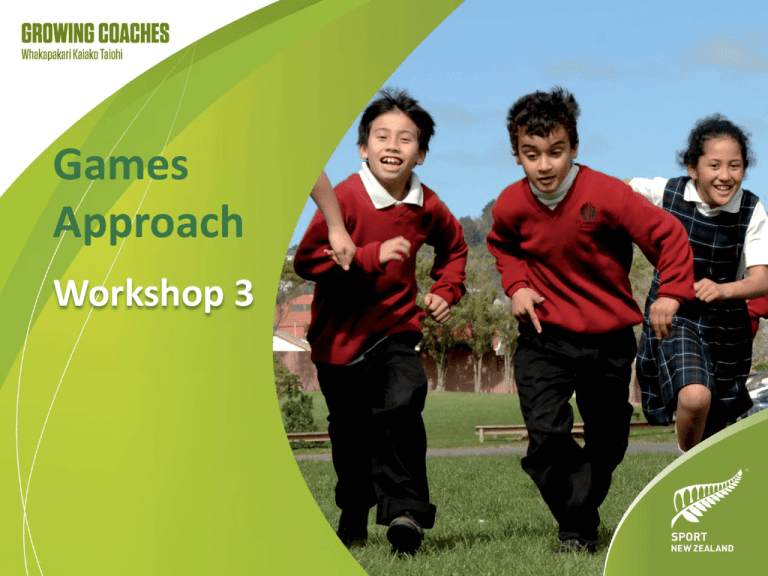
Games Approach Workshop 3 Skill teaching Some suggestions for teaching skills in coaching sessions • teach one skill at a time • allow plenty of time for practice • provide several different ways to practice a skill. This allows lots of opportunities to learn for different types of learners. Skill teaching (continued) Give feedback both positive and corrective throughout the practice time, not just at the beginning and end. Feedback one piece of corrective information then allow the athlete to try again before you give them another piece of information. Skill teaching (continued) If a participant is having trouble performing a skill try the following • • • • • show them again give them the information in a different way get another athlete to work with them ask questions to help lead them to the information themselves break the skill down into ‘learning parts’ for them. Technical and tactical teaching Coaching of technical and tactical skills requires teaching athletes in groups and individually to perform the skill more effectively. Technical skills A technique is a learned movement. The skill is the application of the technique in context, for example • • • • • a dribble in football a hit in hockey a golf swing in competition a sprint start in a race or passing a ball in a game. Tactical Skills Tactical skills revolve around the decisions and actions of athletes in a contest to gain an advantage over the opposing team or athlete. Modifying your activities Allow athletes to observe a range of people so they can appreciate subtle variations in skill and tactics and how it alters outcomes. The problem solving approach (setting problems for athletes to solve or posing questions to them) encourages learners to take more responsibility for their learning. Types of learners Visual learners love you to show them how to do it Auditory learners like to listen to instructions and messages Kinaesthetic learners like to try the activity or the skill Tell me, I’ll forget. Show me, I’ll remember. Involve me, I’ll understand. Anonymous Games and approach to coaching • Games are a powerful coaching tool for teaching strategies and skills in sport. • It is more holistic. • Game understanding is integrated with the learning of techniques and tactics. • It focuses on a ‘doing’ approach where athletes experience and learn by trying things in a game-like context. A games approach session The following chart shows the flow in a coaching session that is a games approach (Teaching Games for Understanding) based Warm Up Activities A modified game Skill Opportunity A modified game Activity A modified game Traditional approach Warmup Practice of previously learned skills Warmdown Introduction of new skills Practice of new skills Game situation – may be a minor game related to the real game Inquiry-based approach Inquiry-based coaching focuses on coaches asking questions and creating curiosity for answers in athletes. Teaching Games for Understanding (TGfU) • A method for effective coaching. • TGfU model was developed during the 1970’s and early 1980’s from the work of Thorpe and Bunker. • A game-centred model that focuses on a more athlete-centred approach that explores tactics and skills in a game context. Teaching Games for Understanding (TGfU) continued Games can be modified by manipulating rules, space and equipment. • This makes aspects easier or more difficult therefore enhancing game understanding and performance. Teaching Games for Understanding (TGfU) continued The games in a TGfU model are organised into four categories: • • • • target Games striking/Running Games net/Wall Games territorial/Invasion Games. When Teaching Games for Understanding (continued) focus on the WHY first and the HOW after by focusing on one or two aspects of the actual game we allow an opportunity to practice aspects that need improvement. The TGfU model allows for the following learning for participants (continued) • • • • • • understanding what the game is about appreciation of rules etc tactical awareness appropriate decision making executing skills performance.
